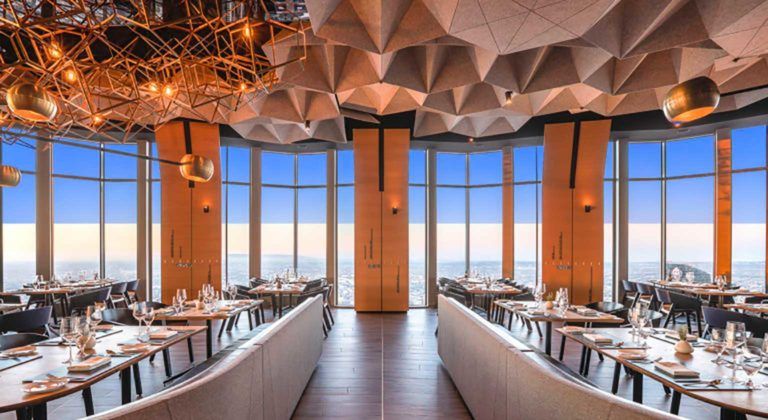
Dynamic glass applications are among the many technologies the commercial glazing industry has developed to improve energy efficiency in buildings. These special coatings change their properties to provide better temperature and light control for a variety of glazing applications, including curtain wall, storefront, and interior installations, to name a few. With their responsive nature, these technologies help to increase the comfort (and at times, privacy) within a given environment while reducing reliance on energy-consuming HVAC and artificial lighting systems.
There are several different categories of dynamic glass technologies on the market, each developed to address specific glazing needs.
The Variables:
Before we dig into the nitty-gritty, here are a few general things to know about dynamic glass:
Electronic vs. Environmental Applications
Broadly speaking, dynamic glass falls into one of two categories: electrically-powered or environmentally-triggered. In electrically-powered applications, a very low electric current is used to shift the properties of the glass. Environmental dynamic glass technologies rely solely on external triggers, like sunlight and temperature, to activate the shift in their appearance and functionality.
Coating Techniques
Dynamic glass technologies are applied as coatings, either on top of monolithic glass or within laminated glass systems. In monolithic applications, the coating that creates the dynamic reaction is applied directly to the surface of the glass unit. In laminated applications, the dynamic component is sandwiched between two pieces of glass, the exteriors of which may be set with additional protections, like tinted films or low-E coatings.
The application process for monolithic and Low-E coatings is the same, so dynamic applications on monolithic glass are often combined with low-E properties as well. However, this type of glass is too thin to be used structurally, and can be more vulnerable to the elements. For glazing that requires more durability, laminated glass is preferred.
Electronically Powered Dynamic Glass
A number of coatings use very small amounts of electricity to activate their dynamic properties, including the following:
Electrochromic Glass
Electrochromic glass — often called “smart glass” — is powered by very low-voltage electricity. It can be programmed to adjust its tint or opacity based on light, temperature, and/or occupancy using sensors, a building management system (BMS), or manual operation. On an immediate level, this glass makes interiors more comfortable, adjusting its color to reduce glare and heat, or increase the amount of natural light within a given space. On a macro level, its ability to optimize the sun’s natural resources reduces reliance on artificial HVAC and lighting systems, saving energy and money in the process.
Of all the dynamic glass on the market, this model allows for the most direct and varied set of controls. It can be applied to monolithic glass, or set within laminated glass to suit a variety of purposes.
Polymer Dispersed Liquid Crystal (PDLC)
PDLC “glass” is actually made from two sets of plastic that are filled with crystal particles suspended in a liquid substrate. This is then laminated between two pieces of actual glass. In their natural state, these crystals arrange themselves randomly, which refracts light and makes the glass appear opaque. Once exposed to an electrical current, however, the crystals align, which results in complete transparency. While this glass is occasionally used in exterior applications, it is far more popular for interiors, especially in office conference rooms, restrooms, and any other space that would benefit from enhanced privacy.
Suspended Particle Device (SPD)
Using a similar concept as PDLCs, SPDs rely on an emulsion filled with charged particles to change the opacity of glass. However, SPDs differ from PDLCs in a few key ways. First, the emulsion is set between two thin layers of conductive plastic to form a pliable film. This film is more versatile than a PDLC system, and can be applied directly onto monolithic pieces of glass, or set within laminated glass. Second, the glass appears tinted rather than opaque, and its tint varies with the degree of wattage used. When no power is applied, the glass is at its darkest, but as voltage increases, so does the transparency. Ultimately, this type of dynamic glass application allows for greater control and more wide-ranging usage than PDLCs.
Related Case Study: See 71Above, Giroux Glass’ largest “smart glass” installation.
Environentally-Powered and Thermochromic Dynamic Glass
The second category of dynamic glass relies solely on environmental triggers to activate its changeable properties. While several varieties of this category exist outside of the construction industry, the primary application used in commercial glazing is known as thermochromic glass.
Perfect for buildings that get a lot of sun exposure, thermochromic applications are activated by solar heat. The more direct the sun exposure, the hotter the glass gets, activating the appearance of a tint. As the sun recedes, the glass cools, and the tint disappears in varying degrees.
This technology offers less control than its electrochromic counterparts, but is helpful for shading large windows from direct sunlight, protecting interiors during the hottest, brightest hours of the day. The coating is applied within laminated glass systems used for office buildings, large residential developments, and other tall, reflective structures. The exterior surface of this glass can be further enhanced with low-E and other protective coatings.
Dynamic glass technologies have evolved to meet the needs of a number of environments, budgets, and preferences. Whether you’re looking to increase energy efficiency, make a space more comfortable, or simply achieve a distinct aesthetic, dynamic glass is a great choice, provided it’s installed correctly. With over 75 years in the business, Giroux Glass is more than qualified to handle the intricacies of dynamic glass and other commercial glazing systems. Contact us at any time to discuss your needs. We’re more than happy to apply our expertise, professionalism, and care to bring your project to life.
